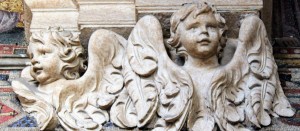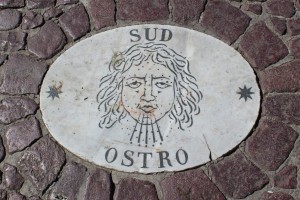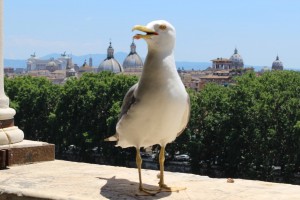… so says Giotto di Bondone, Renaissance painter. It was the middle of June. We were in Rome to celebrate a significant double birthday that suddenly felt, joyfully, incredibly insignificant among an overwhelming density of history and antiquities.
Rome is a gluttony of crumbling arches drenched in sunshine as thick and viscous as olive oil, and every piazza is sizzling with tourists. A scrum of coaches advances up the Viale Aventino, disgorging multitudes into the piazza before the Coliseum, as in Roman times when as many as 80,000 spectators might descend on the arena to watch a smorgasbord of gruesome blood sports involving gladiators and wild animals. Across the city, the hot and stuffy corridors of the Vatican museum swarm with bodies, crawling slowly but implacably towards the Sistine Chapel, like worker bees towards their queen.
We walk up the hill to the Parco del Colle Oppio, away from the dense hoards mobbing the Coliseum, the Forum and the splendid Vittoriano, known locally as the wedding cake. Like London, Rome has many parks, but these Roman parks are not burnished in green, lush and fecund, but parched, droughty and dusty, reminding me of a sun-bleached, South Australian summer. Every blade of grass has been burnt to a yellowed crisp. Umbrella pines are espaliered onto a fierce blue sky, providing scant shade. Pink and white oleander, that venomous evergreen with spiked-tongue leaves, cluster together like gossiping schoolgirls.
Everywhere, pavements are awash with tiny tables, precariously balanced and bedecked in white linen, to tempt the tourists to relax for a quiet moment or two in the shade, with a bowl of pasta and a glass of vino rosso. Everywhere, ancient buildings and monuments are modestly swathed in scaffolding, suggesting never-ending repairs and renovations. Everywhere, marble fountains and statues scream for the hedonistic gush of a high-pressure hose to rid their once opulent lustre of the dull, debauched, ash-grey coating of pollution.
And yet, despite the crush, the prices, the enervating heat, Rome continues to weave a magic that few can resist.
I love to be of the city, not just in it. So, renouncing hotel chains and room service, we have booked an apartment near the termini. Heaving our suitcases off the train, we stagger over wheel-snapping cobblestones while dodging the surging flow of pedestrians, trams, cars and buses, to reach a thick wooden door and three flights of slick and slippery marble stairs. Up, up, up to an airy apartment with lofty ceilings, narrow, shuttered windows and blessed air-conditioning. Here we find a red Smeg fridge, which we fill promptly with beer and bubbles, cheeses and cold chicken, San Pellegrino and salamis.
Leaning out of the window we spy Il Papa’s favourite Basilica, Santa Maria Maggiore, with its Guido Reni frescoes,  mosaics ancient and modern, and the requisite Bernini statue. It’s our first night in town, and we watch from on high, with much interest, the fuss and activity at the end of the road. Later, we learn that His Holiness had dropped into the neighbourhood to say Sunday night mass.
mosaics ancient and modern, and the requisite Bernini statue. It’s our first night in town, and we watch from on high, with much interest, the fuss and activity at the end of the road. Later, we learn that His Holiness had dropped into the neighbourhood to say Sunday night mass.
Beyond the Basilica, down a tree lined road, we descend most evenings upon a cosy restaurant on a leafy square: ‘Tempio di Mecenate’ with its forno a legna (wood oven) and an array of tasty pasta sauces. While our attempts to speak Italian go largely ignored, the One & Only’s Italian name attracts the attention – and the lasting devotion – of the waiter Georgio, even though the One & Only’s Italian is almost non-existent. But that’s OK, the One & Only blithely reassures my poor, disgruntled friend (who has devoted months to learning the lingo) she will be just as easily understood if she simply throws her arms about.
Italian is such a histrionic language.
We walk everywhere. Turning down a narrow lane full of souvenirs and gelati, we emerge in front of the Fontana di Trevi, with its throng of selfie-obsessed young tourists who will only ever see this masterpiece of sculpture on their iPhone screens. We stroll along the River Tiber, channelled between high stone walls and huge leafy trees, flowing ceaselessly around the Isola Tiberina, where wood carvers arrange South American nativities on the balustrades of the Ponte Fabricio.
Near the Spanish Steps, we duck into a wayside church and discover, to our surprise, that it is an Anglican church, the Church of All Saints. Empty of tourists, serene and cool, there is a captivating series of stained glass windows depicting all the saints to whom the church is dedicated. There is a gentle simplicity not common in Rome where more is invariably more in the 17th century Roman Catholic churches, super-sized and excessively decorated in gold and marble to counteract the Reformation. We wander through the calm, warm air and examine the assortment of elegant, stained glass saints and the staid memorials to English expatriates.
 Early one morning, beating the heat, we gather on the steps of Santa Maria delle Popolo for the Angels and Demons tour. There we meet a well-informed, engaging Australian guide, who debunks some of the fantasy, but assures us there is enough fact entwined in the tale to keep us goggle-eyed. She also invents the word volumptuous, which I love and now plan to use regularly. If you have read the book – even if you have only seen the movie – this is a great tour. Much to my relief, we are bussed between the various destinations. Well, it is 32 degrees and the tour, like the book, is a madcap race back and forth across the city: from the Pantheon, home of the world’s largest concrete dome and Raphaelli’s tomb to the myriad putti angels in Saint Marks Square; from the church of Santa Maria Della Vittoria to Bernini’s Fontana Dei Quattro Fiumi and, finally, to the Castel Sant’Angelo, originally Hadrian’s Tomb that provides a fabulous panorama over the city from the battlements. After a long chat with a seagull posing for photos on the parapet, we wander off to collapse for lunch at one of the plethora of pizzerias tucked down the narrow, cobbled alleys that wind around the Piazza Navona.
Early one morning, beating the heat, we gather on the steps of Santa Maria delle Popolo for the Angels and Demons tour. There we meet a well-informed, engaging Australian guide, who debunks some of the fantasy, but assures us there is enough fact entwined in the tale to keep us goggle-eyed. She also invents the word volumptuous, which I love and now plan to use regularly. If you have read the book – even if you have only seen the movie – this is a great tour. Much to my relief, we are bussed between the various destinations. Well, it is 32 degrees and the tour, like the book, is a madcap race back and forth across the city: from the Pantheon, home of the world’s largest concrete dome and Raphaelli’s tomb to the myriad putti angels in Saint Marks Square; from the church of Santa Maria Della Vittoria to Bernini’s Fontana Dei Quattro Fiumi and, finally, to the Castel Sant’Angelo, originally Hadrian’s Tomb that provides a fabulous panorama over the city from the battlements. After a long chat with a seagull posing for photos on the parapet, we wander off to collapse for lunch at one of the plethora of pizzerias tucked down the narrow, cobbled alleys that wind around the Piazza Navona.
On yet another molten morning, we find a light, bright air-conditioned coffee shop full of colourful finger paintings, opposite the Circus Maximus. Sadly, the market we came searching for is temporarily closed, but the coffee is good and the paintings are fun and modern after our undiluted immersion in antiquity.
I was daunted at the prospect of a five-hour tour of the Vatican museum, but in the end, I am utterly dazzled and bewitched by the paintings, sculptures, relics and architecture; this mountain of treasures as endless, as priceless as Smaug’s. It is an exquisite cornucopia of all the super star artists. architects and sculptors of Renaissance Rome that makes your mouth water and your feet forget their blisters: Raphael, Bernini and Boticelli. Da Vinci and Michelangelo. Our guide is a flamboyant, enthusiastic Roman woman with a PhD in art history and a terrific sense of humour, who fills us with apocryphal tales of the live and times of the various artists, then takes us off the beaten track to show us an amazing staircase designed by Bramante. Built in 1505, it is a stairless staircase that rises up to the Belvedere Palace, to the pope’s private apartments, allowing him to remain in his carriage all the way to the front door – and providing him with wonderful views of the city en route.
And thus we spent a whole week swinging from the sublime to the prosaic and back again. We have loved every minute, evening finding time for the odd siesta. And we will return, for as Charles Dickens once said, in Rome there is “a history in every stone that strews the ground,” so there is still plenty more to explore… and plenty more to eat.
* And, as always, the photography is care of the One & Only.


Bellissimo!